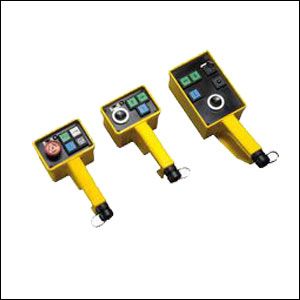
Wireless switchgear
Application:With this system, for example, safety-oriented and operational signals of control devices, as are typically to be found in mobile control housings, can be transmitted without the need of wires. The system is especially qualified under factory environment conditions, as it is precisely here that all HF-critical disturbing influences, such as attenuation, reflections, absorption, diffusion, deflections, refraction and interference have such a particularly strong impact on a system of this nature.Design and mode of operation:The ESALAN wireless system consists of a mobile control housing with integrated transmission electronics including storage batteries and dual band transmitting antenna fitted with EMERGENCY STOP control device, optionally with a 3-step enabling switch or another control device with an effect comparable to EMERGENCY STOP as well as up to four other control devices for movement signals, and a battery charger.Furthermore there is a programmable analysis and control device including receiving electronics and two antenna sockets, with six safety-oriented semiconductor outputs three signalling outputs, and in addition to the radio-based inputs, four additional safety –oriented inputs, as well as receiving antennas, aerial cables and corresponding commissioning and programming software.
...more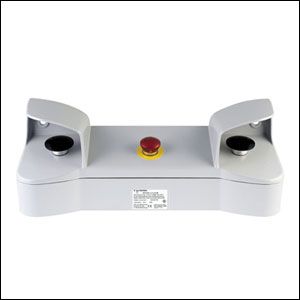
Two-hand control panels
Application:Two-hand control panels are non-separating protection devices. In general, they serve to ensure the location of both hands of a machine operator who gives a control signal for a movement which can be dangerous. Two-hand control panels thus ascertain that intervention by the operator in dangerous moving processes is avoided when a machine or plant has been started.The areas of application include presses for metal working, powder metallurgy, printing and paperprocessing machines, croppers and similar, as well as machinery in the rubber, plastic and chemical industries.Two-hand control panels are the preferred protection devices for use in setting-up work and single-stroke operations for feed and removal processes.Further information on the use of two-hand operation consoles and their evaluation is given in EN 574.In order to achieve Category 0 to EN 60204-1, an additional signal evaluation circuit is needed. Safety monitoring modules for secure evaluation of signals from two-hand control panels and Emergency Stop devices are to be found in chapter xx.Design and mode of operation:Two-hand control panels are protection devices, which require the simultaneous use of both hands for their actuation. By virtue of their forced location, both hands are kept out of the area of danger. In order to start and continue the operation of a machine or plant which can be dangerous, the location of the hands is controlled as long as danger can continue to be present.The two-hand control panels are mounted as standard with an Emergency Stop push button to EN ISO 13850 and two operating units. In addition, there are guard hoods over the operating elements, which prevent simple manipulation of the protection function using hands, elbows, stomach, hips, thighs or knees, for example.EN 574 differentiates between various types of two-hand switching circuits with regard to their technical degree of control security. In this respect, the selection of the type depends on the evaluation and the risk assessment.
...more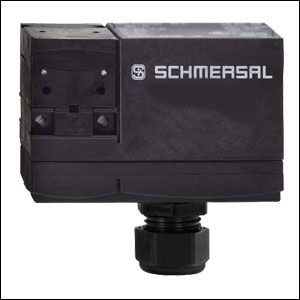
Solenoid interlock
Application:AZM range solenoid interlocks, operating in combination with control elements of a machine, e.g. fail-safe standstill monitors or fail-safe delay timers, ensure that sliding, hinged and removable guarding devices, such as grids, hoods or doors, cannot be opened until hazardous conditions (e.g. running-down movements) have come to an end.These solenoid interlocks are also used for cases in which the opening of a guarding device represents a non-permissible intrusion in a production process.Design and mode of operation:On the AZM range solenoid interlocks, the switching element with interlock is not physically connected to the actuator but functionally brought together or seperated on switching. When the guard device is opened in the uninterlocked condition, the actuator is seperated from the base unit. In the process, NC contacts are positively opened and NO contacts closed.Interlocking is carried out by means of a blocking bolt / latching bolt. This latching bolt blocks the actuator so that it cannot be withdrawn from the interlock. The machine control circuit is only enabled when the actuator has been fed into the interlock and the latching bolt is in the blocking position. This is ensured by contact monitoring of the latching bolt.There are two modes of interlocking. In the case of "Power to unlock", the latching bolt is held in the interlock by spring pressure. When the de-interlocking coil is energised, the interlock is removed and the NC contacts opened. The guarding device can be opened. For "Power to lock 1)", the mode of operation is reversed.The AZM 161, 170, 190 and 415 solenoid interlocks are fitted with protection against incorrect locking. Depending on the type of unit, an individual coding of the actuator are possible.The solenoid interlocks can be fitted in any desired mounting position. Protection class of the solenoid interlocks is IP 54, IP 65 or IP 67.1) In accordance with the policy of the German Technical Assessors, these interlock may only be used after a thorough evaluation of the accident risk, since the guarding device can immediately be opened on failure of the electrical power supply.
...more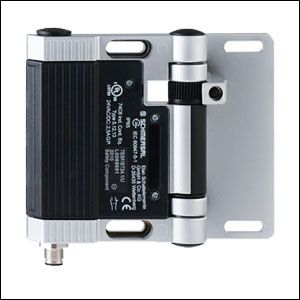
Safety switch for hinged guards
Application:These safety switches are suitable for hinged safety guards, which need to be closed to ensure the necessary operational security.The variety of requirements to be found in practice can be met by means of the wide range of safety switches for hinged guards.Depending on the particular version of the switches, small doors and service flaps as well as heavy hinged doors on engineering machines and plants can be protected in such a way as to provide for easy setting up and maintenance.Design and mode of operation:A general advantage of the safety switches shown here is the integral cam within the safety switch. The requirements of EN 1088, such as positive linkage between cam and actuator as well as protection against tampering are thus fulfilled.This combination within the switch provides cost advantage for the user in avoiding the necessity of mounting a specially designed cam.These safety switches are mounted with slow action.
...more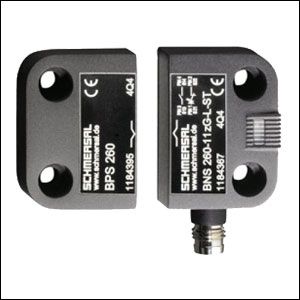
safety sensors
Application:The magnetic safety sensors serve to monitor the position of sliding, hinged and removable safety guards. Sensors without integral evaluation can only be used for safety duties to DIN VDE 0660-209 in combination with a safety guard monitor for protection up to Control Category 4 to EN ISO 13849-1.The use of magnetic safety sensors is of particular advantage in cases where extremely dirty conditions can occur or high hygienic standards need to be maintained. This is provided by the simplicity of cleaning the units.A further advantage is the facility for concealed mounting under non-magnetic materials. Working surfaces and storage areas can be arranged without the need for dust-collecting edges or other functionally required cut-outs or projections.BNS range magnetic safety sensors can also be used in cases where a precise approach is not possible and greater tolerances are required.Design and mode of operation:These devices comprise a multi-channel magnetic safety sensors and an actuating magnet.All magnetic safety sensors are in thermoplastic enclosures and protected to protection class IP 67 or 65.
...more
Safety-related tactile sensor
Application:Actuated by physical contact, tactile safety monitoring devices stop the hazardous movement. The diversity of applications requires constructively different devices.Safety edgesThe safety edges of the SE range are suitable for safe-guarding crushing and shearing points, that can be present on guards, lifting tables and platforms, mobile storage shelving, operating process tables, storage lifts, lift doors, loading ramps, lifting and tilting devices or industrial gates. They immediately stop the dangerous movement, thus preventing physical injury or material damage.Safety flapsThe safety flaps of the SL 300 range are designed for the protection of man and machine at machines with wide material input or feed areas.Safety matsThe safety mats of the SMS range are used to protect surfaces in danger zones on machines and plants with dangerous movements. Depending on the shape of the area to be protected, multiple safety mats can be laid in line and electrically connected. When the safety mat is actuated, a signal is evaluated and the machine stop is initiated.In combination with a suitable connected safety monitoring module, the three above-described systems achieve control category 3 respectively 1 or 4 to EN ISO 13849-1.Design and mode of operation:The SE range safety edges consist of 3 basis elements, i.e. an aluminium profile, a rubber profile and a pair of plug-in sensors.The deformation of the rubber profile of the safety edge is evaluated. The basic element is a fail-safe transmitter/receiver unit in both extremities of the rubber profile. The deformation of the rubber profile reduces or interrupts the IR signal between the transmitter and the receiver. The connected safety monitoring module evaluates the reduction of the IR signal and stops the hazardous movement. This measurement procedure, i.e. in conjunction with a connected safety monitoring module, complies with the safety requirements of control category 4 to EN ISO 13849-1. Solutions for applications of category 1 are also available.EN ISO 13856-2 resumes the requirements for safety edges and describes their design and homologation. Safety-relevant properties such as operating-temperature range, response times, efforts, just-operate travels and over-travels are defined in this norm as well.EN ISO 13849-1 describes the guidelines for the design of safety-related components of the machine control. The risk when using a local machine or unit must be determined. The higher the risk, the more severe the safety requirements for the control.The safety edge system of the SE range with a connected safety monitoring module of the SE-400 C range complies with the safety requirements of control category 4. Even if there are 2 errors in the system, the safety edge will ensure a safe and efficient standstill of the machine or unit.For applications of control category 1 to EN ISO 13849-1 the SE range safety edge can be connected to a safety monitoring module of the SE-100 C range.When using a safety edge, it must be ensured that the speed of the hazardous movement is lower than the maximum starting speed of the safety edge. The stopping distance of the dangerous components and the specific profile data must be adapted to one another. On the one hand, the stopping distance must be sufficient to stop the machine in the worst case and on the other hand the effort exercised on the threatened parts of the body may not exceed the maximum limit. During the planning, attention must be paid to the execution of the opposite sides. If the over-travel of the chosen safety edge is insufficient, then either the stopping distance of the machine is to be reduced either using another model should be considered.The required minimum over-travel must be calculated with a safety factor of at least 1,2. The safety coefficient must be increased if the over-travel is influenced by other machine elements (also refer to EN1760-2 Annex C).SL 300 safety flaps consist of a flap and carrier profile and a position switch class 1. The actuation of the flap profile causes a positive break of the position switch, thus switching off the corresponding machine drive.SMS 3 safety mats include 2 separate currentcarrying steel plates. The plates are held apart by insulating strips. The construction is moulded in Plastisol, a mechanically robust plastic that is highly resistant to chemicals. Upon actuation of the safety mat, the inner steel plates are slightly bent, causing an electrical short-circuit.This signal is evaluated by a connected safety monitoring module, which immediately initiates the machine shutdown.
...more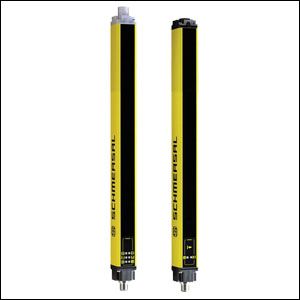
Safety Light Curtains
Application:Optoelectronic safety device are used as entry, danger point or danger zone guards.SLG/SLC range safety light grids and light curtains can be integrated into the safety concept of the machine or plant even under tight space conditions by virtue of their very compact design.These safety devices are also often used on presses to guard danger points or zones. Depending on the paticular resolution of the safety light grids and curtains, protection of persons, hands or even fingers can be provided. SLG/SLC range safety light grids and light curtains achieve Control Category 4 to EN ISO 13849-1.Design and mode of operation:On the SLB/SLC/SLG ranges of optoelectronic safety devices, the emitter and receiver are fitted in two separate enclosures. An invisible infra-red signal is sent from the emitter and this is picked up by the lens system of the receiver and evaluated either by an integral or external safety monitoring module. If the light beam is interrupted, the secure outputs are switched.All of the optoelectronic safety devices listed here are maintenance-free and are characterised by simple fitting and adjustment.
...more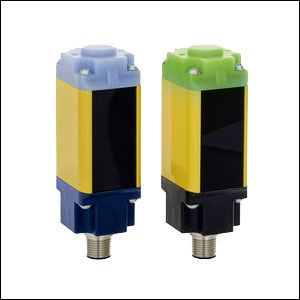
Safety light barriers
Application:Optoelectronic safety device are used as entry, danger point or danger zone guards.SLB range safety light barriers ar utilised as entry guards to dangerous areas. these protection devices operating without physical contact achieve Control Category 2 or 4 to EN 954-1 in combination with SLB 200-C or SLB 400-C safety monitoring modules.Design and mode of operation:On the SLB/SLC/SLG ranges of optoelectronic safety devices, the emitter and receiver are fitted in two separate enclosures. An invisible infra-red signal is sent from the emitter and this is picked up by the lens system of the receiver and evaluated either by an integral or external safety monitoring module. If the light beam is interrupted, the secure outputs are switched.All of the optoelectronic safety devices listed here are maintenance-free and are characterised by simple fitting and adjustment.
...more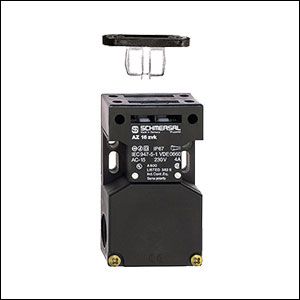
Safe Switching and Monitoring
In the "Safe Switching and Monitoring" section, you will find an extraordinary large programme of safety-related switchgears for the position monitoring of guard doors and the non-contact protection of hazardous zones and danger points, as well as safety switching appliances for special applications.
...more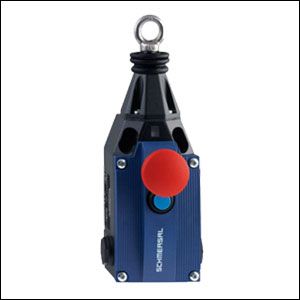
Pull-wire emergency stop switches
Application:Pull-wire Emergency Stop switches are mounted on machines and sections of plants which cannot be protected by guards. In contrast to mushroom head Emergency Stop push buttons, on pull-wire switches the Emergency Stop command can be initiated from any point on the wire.In combination with one of the AES and AZR range safety monitoring modules pull-wire Emergency Stop switches can be used for Control Category 3 or 4 to EN ISO 13849-1.Design and mode of operation:All of the pull-wire Emergency Stop switches conform to European Standard EN ISO 13850. They have a positive linkage between the NC contacts and the wire rope. The pull-wire emergency stop switches are brought into the operational condition by pre-tensioning the wire, i.e. the NC contacts are then closed and the NO contacts open.All of the pull-wire Emergency Stop switches have wire-breakage monitoring. On pulling or breakage of the wire, the NC contacts are positively opened and the NO contacts are closed. The pull-wire Emergency Stop switch can then only be returned to the operational condition by a resetting operation.
...more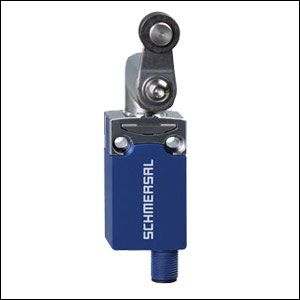
position switch
Application:Position switches with safety function are suitable for sliding and hinged safety guards which need to be closed to ensure the necessary operational security.In combination with safety monitoring modules all position switches class 1 shown in this chapter achieve Control Category 3 or 4 to EN 954-1.Further applications for positions switches class 1 are most varied positioning duties. The variety of requirements to be found in practice can be met in detail by means of a wide range of actuating elements.Design and mode of operation:On the position switches class 1 the guarding device and the positive break NC contact are positively linked.Enclosure rating of all the safety switches is IP 67. The safety switches can be fitted in any desired mounting position.
...more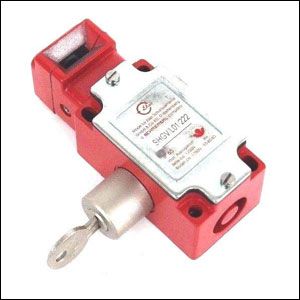
Key Transfer System
Application:The SHGV range is particularly suitable in mor complex production systems and plants to protect divided maintenance and service doors which are used only rarely. Other applications include situations in which an electrical schock is possible, applications with higher ambient temperatures, specific uses in extreme ambient conditions and in chemical and process engineering in view of the explosion protection feature (see also Explosion-protected switchgear).Design and mode of operation:The fundamental functional characteristic of a Trapped key system is that, depending on the operating state of the machine control system, the key is trapped and cannot be withdrawn either in automatic mode (guard locked) in a control element (e.g. key -operated selector switch) or, in the guard locking device, in a key tumbler cylinder, if the guard is open (in an electrically deenergised state).The principle feature of the system is that the removable key is trapped either in the guard locking or in the key-operated selector switch.Ranges SHGV, SVE, SVM
...more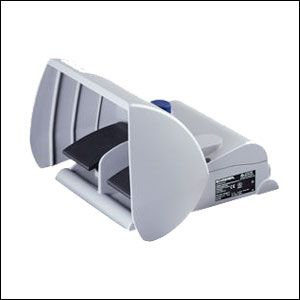
Foot Switch
Application:Safety foot switches are mounted on machines and plants as permissive switches in cases where manual operation is not possible.Design and mode of operation:All safety foot switches are mounted with a shield to protect against unintentional operation. When the foot pedal is actuated to as far as pressure point, the NO contact is closed. If, in case of danger, the pedal is actuated beyond the pressure point, then the positive break NC contact is opened and mechanically latched. Reset operation is carried out by means of a push button. During the reset operation, the switch does not move through the switching-on point.The safety foot switches conform to protection class IP 65.
...more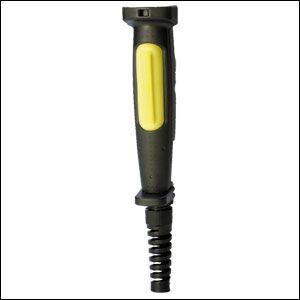
Enabling device
Application:Together with other safety measures, consent switches are used to protect persons from potentially hazardous situations where machine guards need to be inactivated completely or in part in special operating modes.These special situations will typically include setting up a machine, service work or ob-serving processes. If the operator releases the button or - in the case of the 3-stage version - presses the button down completely through the middle setting, the control command is safely interrupted.
...more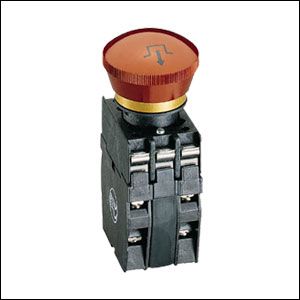
Emergency-Stop button
Application:Command devices are of great importance for the man-machine interface in the area of industrial applications. For example, they are mounted in switch-boards, control panels, two-hand control panels, in lift manufacture and on materials-handling plants, including conveyors. Manual actuation of the devices starts operating sequences and functional processes or serves to bring these to an end.Design and mode of operation:The ES/EM 14 command devices, which are not suitable for use in safety circuits, are available as push buttons, selector switches and key switches. The operators are connected to the contact blocks by a bayonet fastener. This range of devices is also available in EEx version.
...more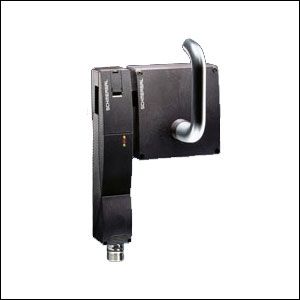
DOOR HANDLE ACTUATOR
Door-handle actuator AZ/AZM 200-B30 Easy and intuitive operation Various handles available With door detection sensor T
...more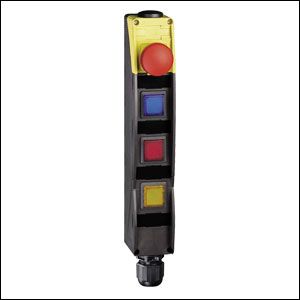
Control Panels
Standard in higher – quality instead of “do-it-yourself”The basis of the BDF series is a slim enclosure in shock-resistant plastic, which can be quickly and smoothly fitted on the customary aluminium profile systems used in mechanical engineering and which can accommodate four control elements. As the control elements are regarded, the user can choose from a comprehensive range of illuminated pushbuttons, selector switches, signalling devices with LED, key-operated switches and standard-compliant emergency stop command devices.Adjustable to the user’s needsAll control elements have the same contacts. In this way, the user can choose their position on the control panel depending on the individual requirements. Also as the labelling is regarded, the BDF control panels can be adjusted to the individual needs. To this effect, labelling areas with plastic cover are provided, in which two-layer plastic identification labels can be applied. In the course of the development, the Schmersal engineers have interviewed many customers about the desired features and functions, which such control panel should include. The results of these surveys have been integrated in the design of the BDF series.
...moreBe first to Rate
Rate ThisOpening Hours